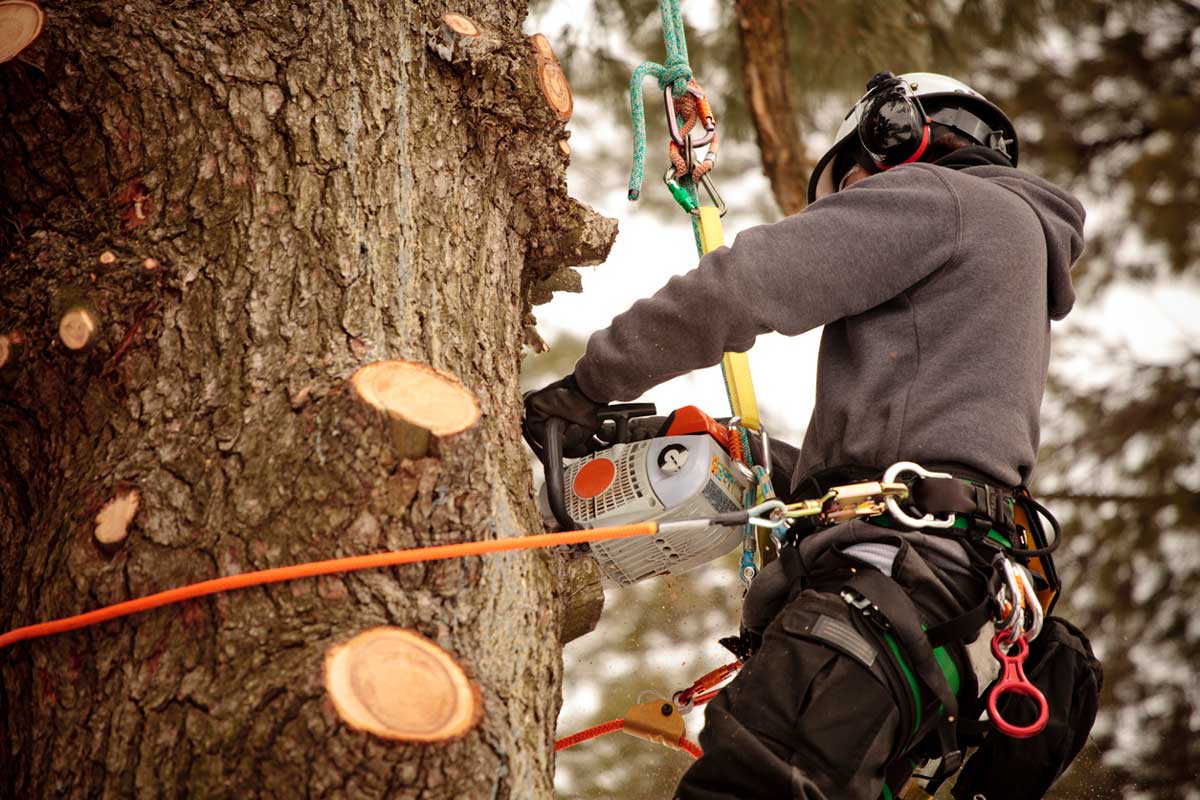Those in the industry will see many of these tools and machines as additional limbs, the machinery as mechanical solutions to some very difficult jobs, and the safety equipment they wear as extensions of their own body for the period in which they are worn. For those with merely a toe (or less) dipped into the aboricultural world, however, you may be curious as to the full repertoire of equipment that tree surgeons and avid arboriculturalists use daily.
From the gigantic spinning blades of the chipper being town to a job at 6am to the small hand-saws, through to the rigging equipment used to lower tree limbs safely and even through to the safety-studded chainsaw trousers worn on the job by all staff, this post is looking to give any and all persons a deeper insight into the equipment we use as well as the brands we most heavily rely on when the line of your work you are in can quite literally be a matter of life and death.
Not All Tools are Created Equal
People most often see a tree surgeon’s most imposing piece of kit when they’re driving to and from a job: the chipper. This allows us to turn cumbersome, bulky, and voluminous logs and gangly branches into a truck-bed full of fresh, compact, environmentally friendly woodchip.
However, the variance in size and type of the equipment, as well as the demands of the job that require us to use such equipment, is great.
Here is an overview of the equipment we use on a daily basis, lumped into categories for your convenience. You will find each piece of equipment depicted in the photo slideshow at the bottom of the page, in the order that they appear in the list:
Large/Heavy Machinery
Chipper
Models we use:Forst ST6 and TR 8 (Tracked)
Perhaps the most prominent and recognisable pieces of equipment used by tree surgeons and arborists across the world, a chipper (or woodchipper) is essential for completing the majority of jobs in a timely and efficient manner. They come in a myriad of sizes across a mountain of brands, but their purpose is simply to reduce tree waste (this could be small branches to sizeable logs, depending on the size of the chipper) to small woodchips.
How does a chipper work?
Most commonly, chippers operate by having a self-contained diesel engine connected to a large rotating drum. This drum or flywheel has multiple blades that rotate extremely quickly, (usually a few thousand RPM). The chippers we use at Cantellow Tree Surgery have a log-feeding system that utilises hydraulics to power multiple rotating rollers that grip any material fed into the large cone-shaped funnel at the front. The tree matter is then chipped in the drum and propelled up and out of the chute.
The most common type of woodchipper used by arborists/tree surgeons is large enough to require towing to each job. Smaller domestic woodchippers are available for avid at-home arborists but these are simply too small to get the job done and are often designed to spray the chip over a wide area. The kind of woodchipper we use is large enough to transform sizeable logs into small pieces of chip that averages just a few inches squared. We also own and use a Tracked Chipper; they can navigate over tough terrain that standard towed-chippers cannot.
What happens to the woodchip?
Depending on our clients’ preferences, it is either aimed and laid directly onto the clients’ land (woodchip makes a great fertile environment for gardens and land intended for growing flora) or we remove the chip from site. We store and sell woodchip used from jobs, a small but vital step towards making my tree surgery business as green and environmentally friendly as possible.
Stump Grinder
Though it may seem like a job is complete when the bulk of the tree is removed, what is often forgotten by those not in the industry is the matter of what to do with the stump. Though the action we take on stumps is ultimately up to the client, leaving a large stump behind after a tree removal can have its problems. This includes pest infestations, as well as aesthetic concerns.
Stumps can, of course, be removed, but for larger trees, this can add significant time and man hours onto the project. This is where the stump grinder comes in. A stump grinder is effectively just a giant rotating blade attached to a powerful motor – they are sharp and large enough to literally strip away the stump bit by bit.
We use the Bandit HB20 Stump Grinder, a beast of a machine that grinds tough stumps to fine chip. The alternative? Manually tracing the roots and digging a stump out of the ground. Needless to say, the Bandit HB20 comes in handy
Log Splitter
Though the image of a man in plaid heaving an axe above his head to chop wood is what most people think of when it comes to splitting logs, there are machines out there that make light work of the once-painstaking work of splitting the logs from felled trees.
Machine log splitters are effectively portable hydraulic presses that exert their force horizontally. Simply place the log you want split into the recess on the machine, and the hydraulics push the log against the blades, splitting them into quarters or halves.
Using log splitters allows us to process wood in a fraction of the time it would take to split logs manually. This lets us process our wood so we can begin the seasoning process before selling our high-quality wood to customers.
Skid Steer (including Log Grab, Bucket, and Pallet Forks)
We use a Ditch Witch skid steer as it allows us to manoeuvre its attachments to virtually anywhere we need it when on the job. This self-contained unit allows us to navigate uneven terrain and allow us to use the attachments.
The log grab and bucket allow us to lift and transport large logs/large quantities of wood across a site and to the van for removal. Pallet forks are equally as useful for transporting material from point A to point B.
Small/Portable Machinery
Chainsaws
The chainsaw is the tree surgeon’s scalpel, allowing us to make exactly the right cuts in the correct places at the right times. Petrol chainsaws are the most overwhelmingly common kind since they simply last longer on a full tank than battery-operated versions, while corded electric chainsaws are decidedly impractical and present various safety hazards.
Size Matters
Chainsaws are far from a one-size-fits-all item. Generally, we try to aim to utilise a saw with a guide-bar length – i.e., the length from the tip of the chain to the main engine housing – that is one or two inches greater than the largest diameter of the tree we are cutting. Given that we deal with a huge array of branch and trunk diameters, this means having a hefty range of saws to cover all types of job, from small domestic to larger commercial.
We work with chainsaws that range from small climbing saws that can be clipped on to our harnesses as we navigate a tree’s crown, all the way up to hefty 30+ inch workhorses that allow us to fell the heftiest of trees with the largest of trunks.
Though I’ve used a range of saw brands over the years, none have been quite as reliable as the Husqvarna chainsaw range. Stihl is another great brand that we choose for our peripheral machinery (listed below)
Safety is also paramount with chainsaw work – Cantellow Tree Surgery takes safety seriously, using the best safety equipment money can buy (see PPE section below)
Hedge Cutters
Standard and Telescopic hedge cutters do precisely as the name implies. We use petrol hedge cutters due to portability, as well as models with telescopic extenders, which allow us to reach otherwise unreachable parts of hedges, for a professional finish.
Blowers
Gone are the days of sweeping up woodchip and sawdust manually with a pan and brush. Though we do use brushes to finish off at the very end of a job, motorised blowers allow us to quickly disperse sawdust and move large amounts of brash and leaves into a more manageable pile for gathering and removal.
Silky Saw
A silky is just a small, fold-out hand saw with extremely coarse teeth and a curved blade. This allows us to remove smaller branches that would cause a chainsaw’s chain to kick or the branches to whip dangerously.
Rigging and Felling Equipment
A fair amount of thought and calculation must go into not just the felling and removal of trees, but also the way they can fall. Some limbs and branches are too heavy or are too precariously placed to simply be allowed to fall to the floor. This is where rigging equipment comes in.
The kind of rigging equipment used does vary from person to person, however most tree surgeons and arborists will often be found with (at a minimum) a strong rope and rope bag, a rigging block for separating and sorting the various ropes and lines, various karabiners to hook and guide the ropes, as well as a variety of winches, pulleys, and slings.
PPE
Protective equipment is also an essential component for the safety and wellbeing of my team.
Climbers will always wear climbing helmets with visor, as well as the appropriate chainsaw trousers, protective gloves, and protective footwear.
Groundsmen also need safety boots and chainsaw trousers.
Chainsaw clothing most often contains an abundance of fabric designed to immediately tangle and halt the chain’s motion around the guide bar.
Climbing Gear
Climbing Harness
A tree surgeon’s life is literally at the mercy of the harness that he or she wears. The harness attaches to the body and allows the wearer to attach a variety of items to it (including chainsaws, as well as various anchor points to allow for hands-free suspension within the tree).
Climbing Rope, Throw Bag, Prussic/Friction Hitch
Another vital piece of equipment is a climber’s rope. These are extremely durable ropes that act as the main line for the climber to climb. With the aid of a throw weight (or a well-bunched rope and good throwing technique), a tree surgeon calculated the best pivot/anchor point on a tree at any one time, then utilising a Prussic/Friction hitch to manipulate the length of the rope that’ remains above or below.
The friction hitch allows for free movement of the rope in both directions when the right pressure is applied, while a massive amount of friction holds it in place when it needs to hold the weight of the climber to fix their position on that portion of the rope.
A risk assessment and professional judgement is also used when deciding whether to use a two-rope system, or just a single main rope with additional secondary loops to tighten around a secondary anchor point for steadying.




